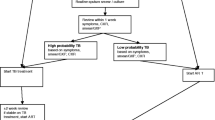Abstract
The aim of the study presented here was to determine the incidence, risk factors and prognostic indicators of Mycobacterium avium complex (MAC) infection in HIV-infected subjects prior to and after the introduction of highly active antiretroviral therapy (HAART). In the HAART era, the incidence of MAC infection decreased significantly from 3.7 to 0.9 per 100 person-years. Using logistic regression analysis, a high acute physiology and chronic health evaluation (APACHE) III score, a low number of CD4+ cells/mm3 and a high level of HIV viremia were found to be independent predictors of the risk to develop MAC disease; however, a high APACHE III score was the only prognostic indicator associated with an unfavourable outcome of a disseminated MAC infection. These results indicate that MAC infections, although considerably less frequent in the HAART era, are still responsible for cases of severe disease.
Similar content being viewed by others
Author information
Authors and Affiliations
Rights and permissions
About this article
Cite this article
Tumbarello, M., Tacconelli, E., de Gaetano Donati, K. et al. Changes in Incidence and Risk Factors of Mycobacterium avium Complex Infections in Patients with AIDS in the Era of New Antiretroviral Therapies. EJCMID 20, 498–501 (2001). https://doi.org/10.1007/PL00011292
Issue Date:
DOI: https://doi.org/10.1007/PL00011292




